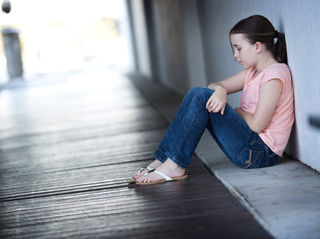Health
The Child Mental Health Crisis
What you need to know.
Posted May 26, 2017 Reviewed by Devon Frye

Severe mental illness is challenging enough for adults to manage. Many spend years seeking treatment before they find something that works. For children, the picture is even grimmer. Recent research suggests that the rate of suicide and suicidal thoughts among children is skyrocketing. What’s behind this crisis in child mental health?
Here are five key facts you need to know:
1. Suicide is a children’s issue, too.
The national suicide rate has risen dramatically, reaching a 30-year high in 2014. Experts cite a number of potential factors, including thwarted dreams due to the 2007-2009 economic downturn, inadequate access to mental health care, and changing cultural norms.
Most of these purported explanations do little to explain what’s behind child suicide, and that’s a problem, because child suicide has increased, too. From 2008 to 2015, the number of children admitted to hospitals for suicidal actions or thoughts more than doubled. And while teenagers and preteens still commit suicide more frequently than young children, there’s another alarming trend behind the scenes: Very young children are taking their lives at unprecedented rates. Over the last decade, girls aged 10-14 experienced a three-fold increase in their suicide rate.
2. Being a kid is hard.
One problem children face when they experience mental health issues is the fantasy many adults have constructed around childhood as a carefree time full of support and love. That’s not always the case. Being a child is hard. Not only do kids have little control over their own lives, they’re also subject to the whims of teachers and parents. So children with parents who don’t notice or don’t care about their symptoms may not get treatment, and kids in failing schools may not get support for academic issues.
One of the most significant trends of the past decade is the widespread use of social media. Research consistently suggests that bullying is rampant, and that social media bullying is different from the schoolyard bullying with which many parents are familiar. A child can be publicly and aggressively bullied, in a medium that makes the content of the bullying permanent, without parents ever knowing—and without even leaving home. Several high-profile suicides have been linked to social media bullying.
3. Parents need to be mindful of the new stresses kids face.
These include:
- A more competitive academic environment than ever. Research shows that suicide rates tend to increase around the time of high-stakes academic testing. For high school students, the pressure to get into a good college can be especially overpowering.
- Greater access to information, including about themselves and their peers, than ever before. Not all kids are equipped to handle this information.
- An opioid abuse epidemic. For many children, a drug found in a parent’s medicine cabinet is the gateway to abuse.
- A world of body image pressures that conspire to harm both boys and girls.
4. Children face long waits and delays in receiving care.
You might think that a child in the midst of a mental health crisis would be a high priority. Research suggests that’s not the case: One recent study found that parents seeking the assistance of developmental specialists faced a number of access barriers, including:
- No language or other accommodations for parents and children who needed them.
- Long wait times, with many programs refusing to offer a wait time estimate.
- Difficulty reaching programs, many of which did not answer the phone or promptly return phone calls.
Another study found that parents searching for mental health care via their insurance carriers often turn up nothing. Researchers called various specialists posing as parents seeking care for a depressed child. Many numbers weren’t working. In other cases, the doctor was not seeing new patients or never got back to the families.
5. Financial barriers and economic inequality are barriers to care.
Even for parents who are able to access qualified care providers, there’s another barrier—economic inequality. Insurance companies are technically required to cover mental health care, but reports suggest they often refuse to offer coverage equality for mental and physical concerns. It’s common for claims to be denied, for insurance to pay only pay for medication, or for companies to place limitations on how many therapy sessions a child can receive. Each of these practices increases a child’s vulnerability to chronic mental health issues.
Children may also be limited by insurance plans to specific providers, although not all providers are equally equipped to treat all conditions.
Early Intervention Can Save Lives
Most children who commit suicide have a mental health diagnosis, so access to mental health care can and does save lives. Moreover, child mental health interventions may save adults from mental health disorders. Mental health issues are treatable, but prolonged issues that go untreated in childhood may become chronic issues in adulthood.
LinkedIn Image Credit: GagliardiPhotography/Shutterstock
References
Children's hospitals admissions for suicidal thoughts, actions double during past decade. (2017, May 10). Retrieved from http://www.aappublications.org/news/2017/05/04/PASSuicide050417
Curtin, S., MA, Warner, M., PhD, & Hedegaard, H., MD, MSPH. (2016, April 22). Increase in suicide in the United States, 1999-2014. Retrieved from http://www.cdc.gov/nchs/products/databriefs/db241.htm
Harley, N. (2016, May 26). Exam stress among causes of teen suicide. Retrieved from http://www.telegraph.co.uk/news/2016/05/26/exam-stress-among-causes-of-…
Jimenez, M. E., Alcaraz, E. M., Williams, J., & Strom, B. L. (2017). Access to developmental pediatrics evaluations for at-risk children. Journal of Developmental & Behavioral Pediatrics. doi:10.1097/dbp.000000000000042
Scutti, S. (2017, May 05). 'Alarming' rise in children hospitalized with suicidal thoughts or actions. Retrieved from http://www.cnn.com/2017/05/05/health/children-teens-suicide-study/
Study: Many parents in need can’t find mental health care for their children - The Boston Globe. (2017, May 09). Retrieved from https://www.bostonglobe.com/metro/2017/05/09/study-many-parents-need-ca…




